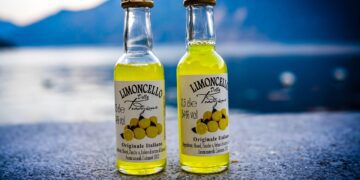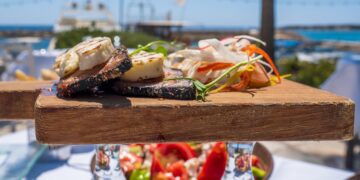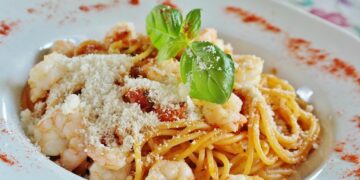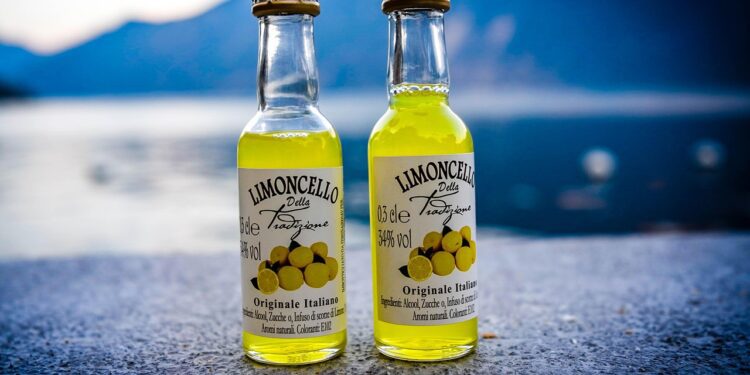Updated July 2025
If you’ve ever finished dinner on the Amalfi Coast, you already know the ritual: a tiny, frosted glass, straight from the freezer, filled with liquid sunshine. Limoncello is Italy’s most famous lemon liqueur, born between Sorrento, Amalfi and Capri, where thick‑skinned lemons grow on terraced groves overlooking the Tyrrhenian Sea. This guide covers how it’s made, how to serve it properly, the difference between limoncello and limoncino, trusted brands to try in the UK, and the best cocktails and desserts to make at home.
What exactly is limoncello?
Limoncello is a sweet, lemon‑zest liqueur typically bottled at 25–32% ABV. The bright flavour doesn’t come from juice; it comes from the lemon peel oils extracted in neutral alcohol. The result is intensely aromatic, zesty rather than sour, with a clean, lingering finish.
Where Limoncello comes from (and why Amalfi lemons matter)
Most stories point to the early 1900s in coastal Campania. Citrus has been grown here for centuries, and the Sfusato Amalfitano lemon is prized for its thick, fragrant peel, the perfect raw material for limoncello. Tiny family producers still macerate zest in small batches, then sweeten with simple syrup and rest the liqueur before bottling.
How limoncello is made (the short version)
- Zest unwaxed lemons (just the yellow; avoid the bitter pith).
- Macerate the zest in neutral alcohol for 5–10 days until the spirit turns deep yellow.
- Sweeten with cooled simple syrup and rest to marry the flavours.
- Bottle & freeze. Good limoncello turns slightly opalescent (the louche) when chilled or mixed—those lemon oils are real.
Crema di Limoncello swaps part of the water/syrup for milk or cream, making a lower‑ABV, dessert‑like liqueur. It’s luscious, but it doesn’t keep as long (see Storage).
How to serve limoncello like an Italian
- Temperature: as cold as possible; store in the freezer.
- Glass: small cordial or ceramic shot glasses.
- When: as a digestivo after meals, or as a low‑effort aperitivo over ice with a splash of soda.
- Pairing: excellent with lemon‑forward desserts, fruit tarts, ricotta cake, or even a bowl of gelato.
Limoncello vs. Limoncino (and Meloncello)
You’ll see both limoncello and limoncino on labels. In some regions they’re used interchangeably; elsewhere, limoncino signals a lighter or slightly different recipe. Meloncello is a separate, melon‑based liqueur, sweet and creamy, often enjoyed the same way as an after‑dinner treat.
Trusted brands to try (UK‑friendly)
If you’re buying rather than making, these names are widely available and a great start:
- Pallini Limoncello (including 1‑litre bottles): clean, bright zest character; freezer‑friendly and giftable.
- Luxardo Limoncello: punchy lemon oils with classic sweetness.
- Villa Massa: balanced and aromatic; good all‑rounder.
- Bottega Limoncino: lighter style; nice in spritzes.
Non‑alcoholic & low‑alcohol options
True “non‑alcoholic limoncello” is rare because alcohol extracts the lemon oils. If you’re avoiding alcohol, look for lemon aperitif syrups/cordials made for spritzes and mocktails, or make a “NA limoncello” syrup: simmer lemon zest with sugar and water, rest overnight, strain, and chill.
Storage, shelf life & “does limoncello go bad?”
- Classic limoncello: unopened keeps well for a year+; opened bottles are best within 6–12 months. Freezer storage preserves aroma.
- Crema di limoncello: consume within 1–3 months of opening; keep refrigerated and don’t freeze repeatedly.
- Signs to replace: dull aroma, harsh bite, separation that won’t recombine, or off smells.
Calories & nutrition (rule‑of‑thumb)
This is a dessert‑style liqueur, enjoy as a treat. Calories vary by brand and sweetness, but a small 25–50 ml pour is typical.
Quick recipes (Italian‑leaning, metric, tested)
Easy Limoncello Spritz (Aperitivo‑style)
- 90 ml Prosecco
- 45 ml limoncello
- 30–60 ml soda water
- Lemon slice & a basil leaf (optional)
Build over ice in a wine glass. Prosecco → limoncello → top with soda. Stir gently.
Gin & Limoncello Cooler
- 35 ml dry gin
- 25 ml limoncello
- 10 ml fresh lemon juice
- Top with soda
Shake first three with ice, strain into a tall glass with ice, top with soda.
Limoncello Mojito (Italian twist)
- 6–8 mint leaves, 2 tsp sugar, 15 ml lime juice (muddle)
- 45 ml white rum, 25 ml limoncello
- Top with soda; stir and add crushed ice.
Limoncello Sorbet (no churn)
- 400 ml lemon sorbet (softened)
- 45–60 ml limoncello
Fold together, refreeze 1–2 hours. Scoop and serve with lemon zest.
Meloncello (Crema di Melone): Italy’s Creamy Melon Liqueur
Where limoncello tastes like the peel of sun‑ripened Amalfi lemons, meloncello, also called crema di melone, is summer in the form of ripe melon and cream. You’ll see it most often in southern Italy. It pours a soft peach‑to‑apricot colour, smells like chilled cantaloupe, and sips like a dessert.
What it is (and how it differs from limoncello)
- Base flavour: ripe melon (usually cantaloupe; some makers use other varietals).
- Texture: creamy and velvety (dairy‑based), versus limoncello’s clear, zesty profile.
- Strength: typically, lower ABV than limoncello because of the cream component.
- Use: served ice‑cold in tiny glasses as a digestivo, or folded into desserts and spritzes.
How meloncello is made (the short version)
- Infuse melon (and sometimes zest or seeds for aroma) in neutral alcohol.
- Blend with a sweetened dairy base (milk/cream).
- Rest & bottle, then chill thoroughly before serving.
Because it contains dairy, it’s more delicate than limoncello and best enjoyed fresh.
How to serve meloncello like an Italian
- Temperature: very cold; store in the fridge, then give it 15–20 minutes in the freezer before pouring.
- Glass: small cordial, shot or ceramic cup.
- When: after dinner, or as a short, creamy treat in the afternoon heat.
- Pairing: panna cotta, fruit tarts, almond biscuits, vanilla gelato.
Storage & shelf life
Meloncello should be treated like a cream liqueur: keep refrigerated after opening and aim to finish the bottle within a few months for best flavour. Avoid repeated freeze–thaw cycles.
Limoncello vs Meloncello (at a glance)
| Feature | Limoncello | Meloncello (Crema di Melone) |
| Core flavour | Lemon peel oils (zest) | Ripe melon + cream |
| Look & texture | Clear, bright yellow; light‑bodied | Peach/apricot hue; creamy |
| Typical use | Digestivo from the freezer; spritzes, cocktails, desserts | Digestivo well‑chilled; creamy cocktails & desserts |
| ABV | Generally higher | Generally lower (cream‑based) |
| Longevity | Keeps well; flavour slowly fades | Shorter shelf life once opened (refrigerate) |
Want the zesty, citrus‑peel pop? Go limoncello. Craving a soft, dessert‑like sip? Try meloncello.
Quick Italian‑leaning recipes to add variety
Meloncello Spritz (creamy, refreshing)
- 60 ml meloncello
- 90 ml Prosecco
- 30–60 ml soda water
- Slice of fresh melon
Build over ice in a wine glass: meloncello → Prosecco → top with soda. Gentle stir.
Meloncello Martini (dessert‑style)
- 45 ml vodka
- 45 ml meloncello
- 10 ml simple syrup (optional, to taste)
Shake hard with ice, strain into a chilled coupe. Garnish with a tiny melon ball.
Affogato al Meloncello
- 1 scoop vanilla gelato
- 30–45 ml meloncello
Spoon the gelato into a small bowl and pour meloncello over the top. Serve immediately.
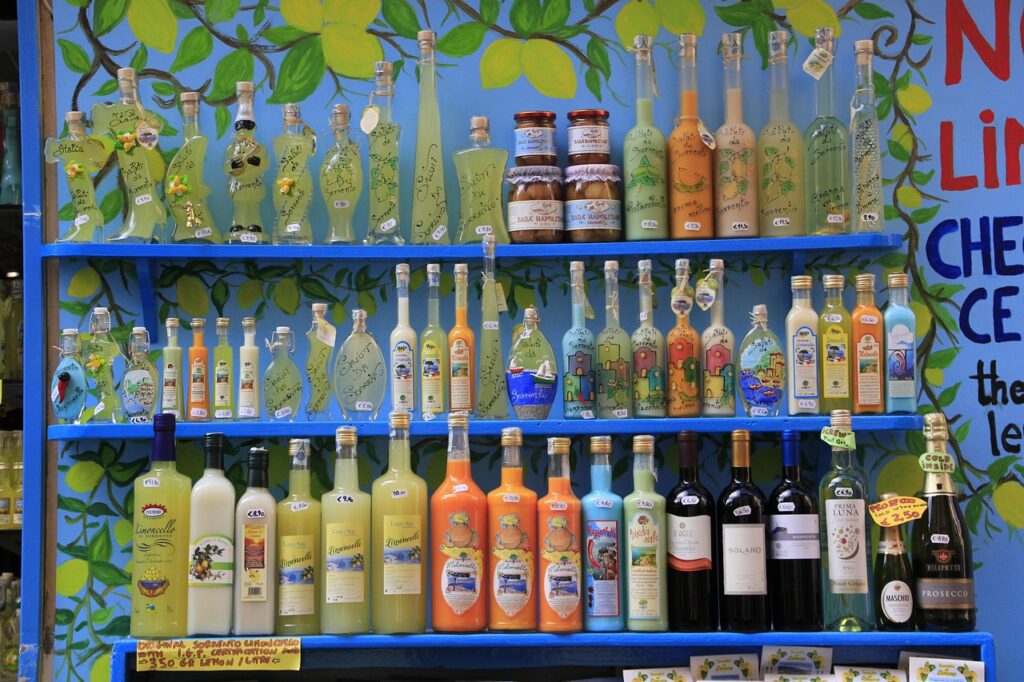
Frequently Asked Questions
Most bottles sit around 25–32% ABV; crema versions are often lower.
Straight from the freezer in small glasses as a digestivo, or long over ice with soda as an aperitivo.
Small cordial/shot glasses or traditional ceramic cups; thin glass holds the chill.
Sugar and alcohol preserve it, but flavour fades. Use within 6–12 months after opening; crema versions much sooner.
Not in the strict sense; use lemon aperitif syrups/cordials for mocktails or make a zest syrup.
Often yes, sometimes a regional name difference; some limoncino labels indicate a lighter style.
Ripe melon infused in alcohol, blended with a sweetened cream base, then chilled.
Yes—meloncello is commonly a cream‑based melon liqueur, often labelled crema di melone.
Usually lower‑ABV than limoncello because of the cream component. It drinks like a light dessert liqueur.
Refrigerate after opening and enjoy within a few months for best flavour. Avoid repeated freeze–thaw cycles.
Absolutely—try it in panna cotta, tiramisù riffs, trifle, or poured over vanilla gelato.

